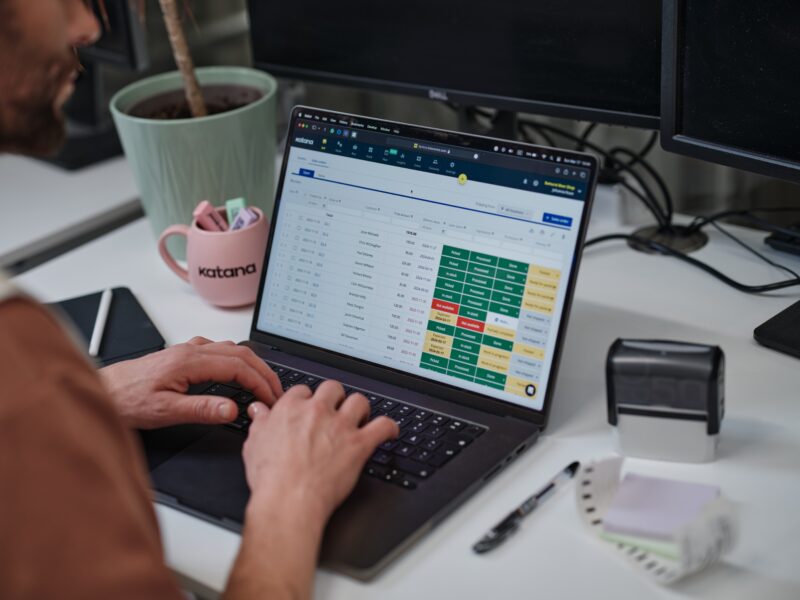Grow with small business inventory management software
Katana is the ideal inventory management software for small businesses that’s ready to scale with your company. Automate your daily operations with Katana and take your business to the next level.
Better inventory management,
smarter daily operations
Katana’s cloud inventory platform for small businesses equips you with everything you need to grow your organization. Streamline your workflow with Katana and get a live view of your inventory, production operations, and sales.
Cloud-based inventory management for easy access to your business
As your business grows, in size of team or income, you need to move from manual processes to using more automation. Retail companies will look to match pace with their sales, but any business looking to expand or adapt to a growing market needs to lighten the burden of paperwork and unnecessary admin.
Here’s how Katana’s features can help you do that:
- Update and prioritize orders to automatically update stock levels and understand what’s on hand at any moment
- Create multiple bills of materials (BOMs), so you know exactly what makes up each product
- Customize the way your stock is measured, by pieces, liters, feet, etc., whatever you need
- Add notes or comments so your production team has all the information when making products
- Access all the information from a single platform without needing additional tools or spreadsheets

Smarter business inventory management with clearer data and added automation
As automation grows, you can look at centralizing inventory management into one place and optimizing inventory management to make smart decisions at a quicker pace. You’ll be able to create inventory reports, understand your lead time, and calculate safety stock.
Here are a few more Katana features that make managing inventory easier:
- Set your reorder points based on specific stock levels
- Project your lead times so production matches demand and customers stay happy
- Work in multiple currencies to give your customers a choice about how they pay you
- Use the Shop Floor App to work with your warehouse teams and manage daily tasks

Integrations that amplify your sales, accounting, and overall performance
Katana offers a wealth of integrations to assist with business accounting, shipping, CRM, and multichannel e-commerce. Seamlessly integrate Katana’s small business inventory software with your favorite platforms and keep all your business data in sync. No more copy-pasting information between apps.
Katana’s inventory management software for small businesses makes it easy to:
- Synchronize sales between all your online and offline sales channels
- Keep your inventory, sales, and accounting data in sync without laborious copy-pasting
- Track your inventory in real time across multiple locations
- Eliminate human errors and save countless hours spent on transferring information between spreadsheets
Inventory management software that integrates with your favorite tools for a smooth workflow
From native integrations to codeless templates or fully customizable API integrations
Katana cloud inventory software’s batch production features give users access to the API, allowing you to create custom workflows and connect your business apps to manage your sales, manufacturing, and accounting all on one platform. Automate data transfers between the services you use to level up efficiency. Take a look at our API documentation to learn more.
With Katana, we can track products, build recipes for materials, and set reorder points as well. That was one thing that was very difficult to manage — raw material inventory — for example, how many black t-shirts do I need to order? That was the main reason why we selected Katana.”
Lisa DiepChief Operating Officer (COO) at Peace Collective
With Katana, we can more effectively see and follow inventory levels, and have recipes and bills of materials (BOMs) for our manufactured products that let us follow the manufacturing status throughout the whole production cycle.”
Richie Duncan
Founder at Kodama
I used to spend around 15 minutes per individual order on admin work, and I would be doing it all – preparing the packing lists, labels, and shipping. Now I do not need to touch any of that. Instead, I can put this time into designing new products and developing the business.”
Thomas JudgeOwner at GJ Motorsports
We needed something more than just a spreadsheet but we didn’t like to pay a crazy amount for a system we wouldn’t fully use. Tracking inventory and what stage it is in has been incredibly helpful. It’s helped our team have a clearer delineation of the order of operations for each product in our catalog.”
Sarah Zinger
Director of Production Logistics at System76
Inventory management software for small businesses FAQs
The best inventory method for a small business often depends on the specific needs and scale of the business. However, a common and efficient approach is to use inventory management software for small businesses. This software allows for real-time tracking and management of inventory levels, ensuring accuracy and efficiency.
For very small operations, a periodic inventory system or a perpetual inventory system using basic spreadsheets may also be effective.
Small businesses typically manage inventory by utilizing small business inventory software, which streamlines the process of tracking stock levels, orders, sales, and deliveries. These systems often include features like barcode scanning and real-time data analysis, aiding in decision-making and reducing the risk of overstocking or stockouts.
Additionally, regular inventory audits and a clear understanding of inventory turnover are essential practices.
The cost of an inventory management system for a small business varies widely based on factors like features, scalability, and vendor.
Basic inventory software for small businesses can start from as little as $50 per month, while more advanced systems with extensive features may cost several hundred dollars per month.
Many providers offer tiered pricing plans, allowing businesses to choose a package that fits their budget and needs.
The four main types of inventory are:
- Raw materials — Basic materials used to produce goods
- Work-in-progress (WIP) — Items that are in the process of being manufactured but are not yet complete
- Finished goods — Completed products ready for sale
- Maintenance, repair, and operating (MRO) — Items used in the production process but not part of the final product, such as lubricants, tools, and cleaning supplies
Effective inventory tracking software for small businesses can help manage these various types of inventory efficiently, ensuring optimal stock levels and reducing waste.
Get visibility over your sales and stock
Wave goodbye to uncertainty with Katana Cloud Inventory — AI-powered for total inventory control
